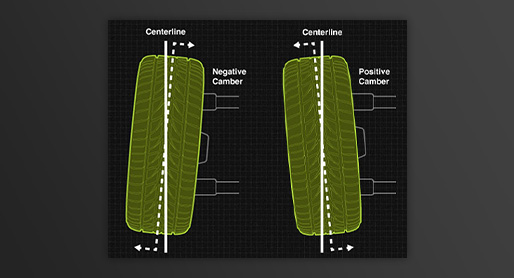Common terms used in Wheel Alignment
Introduction- What is Wheel Alignment?
- Wheel alignment / Tire alignment does not actually refer to the vehicles’ wheels but rather to the suspension system.
- Specific adjustments are made to the Suspension systems to optimize ride handling characteristics & steering characteristics.
- Every automobile manufacturer specifies precise settings to achieve the maximum performance to their vehicle models.
Why do we need Wheel Alignment?
Doing WA can help the tyres to perform properly and help them last longer.Also, to improve the following characteristics:
- For correct vehicle handling
- Even the tyre wear
- Safest stopping distance
- Increase fuel economy (mileage)
Common Symptoms of Wheel Alignment
There are couple of ways to tell that a vehicle is due for an alignment check, these are :
- Uneven Tread wear
- Vehicle pulling to one side (either to the left or right)
- The steering wheel is off centre when driving straight
- Steering wheel vibration.
What happens during Wheel Alignment?
- The alignment angles such as the toe, camber & caster is measured with the help of Alignment machines .
- The technician will then adjust those angles to match the vehicle manufacturer’s specifications, ensuring a smoother ride, evens the tire wear and improve the fuel mileage.
Wheel Alignment Angles
These angles can be classified into 2:
Primary Angles :
- Toe
- Camber
- Caster
Secondary Angles :
- Steering Axis Inclination (SAI)
- Toe out on turns
- Thrust Angle
- Set Back
Wheel Alignment angles: Toe
Viewed from the Bird’s Eye (Top) view.
Toe is measured in mm or in degrees.
The sum of the left and right toe is called total toe.
The distance between the front of the wheel is a little narrower than the distance between the back of the wheel. This condition is called toe-in.
Conversely, when the distance between the back of the wheel is a little narrower than the distance between the front of the wheel it is called toe- out.


Wheel Alignment angles: Camber
Viewed from the front view of the vehicle
Camber is measured in degrees.
If the top of the wheel is leaning OUT from the centre of the car, then the camber is positive (+), if it’s leaning IN, then the camber is negative (-)
Wheel Alignment angles: Caster
- Viewed from the side of the vehicle
- Caster is measured in degrees.
- Generally refers to the angle between the center of the wheel & upper mounting point of the suspension.
- All cars require positive caster. Greater the angle the heavier the steering will feel, but at the same time it will have an improved self centering effect.


Wheel Alignment angles: SAI/ KPI/ BJI
- The angle formed by the centre line of the ball joints/ struts and the true vertical as viewed from the front of the vehicle.
- This angle has a direct effect on steering & handling
- The SAI is a Fixed and a Non- Adjustable angle that is designed into the suspension
- If the SAI is out of specification there are possibilities that either the steering or the suspension components are bent and could be corrected only by replacing the spindle.
Wheel Alignment angles: Thrust Angle
- Thrust angle is the direction that the rear wheels are pointing in relation to the centre line of the vehicle.
- If the thrust angle is not zero, then the vehicle will dog track and the steering wheel will not be centred.
- The best solution is to adjust the rear toe to the centre line and then adjust the front toe.

Wheel Alignment angles: Set back
- Also causes brake pull.
- Causes the vehicle to steer to one direction
- Usually specified in degrees and should be generally be less than half a degree
- Set Back is the amount by which one wheel farther back from the other wheel

